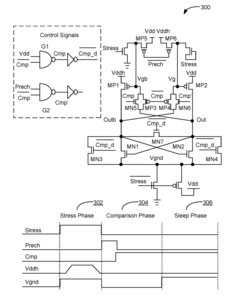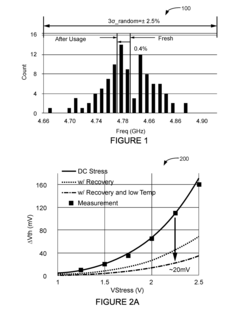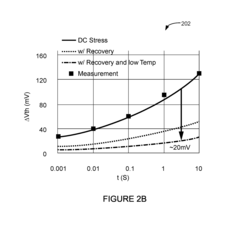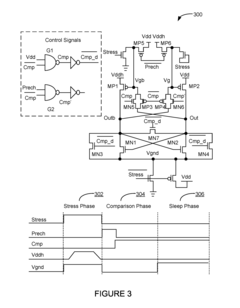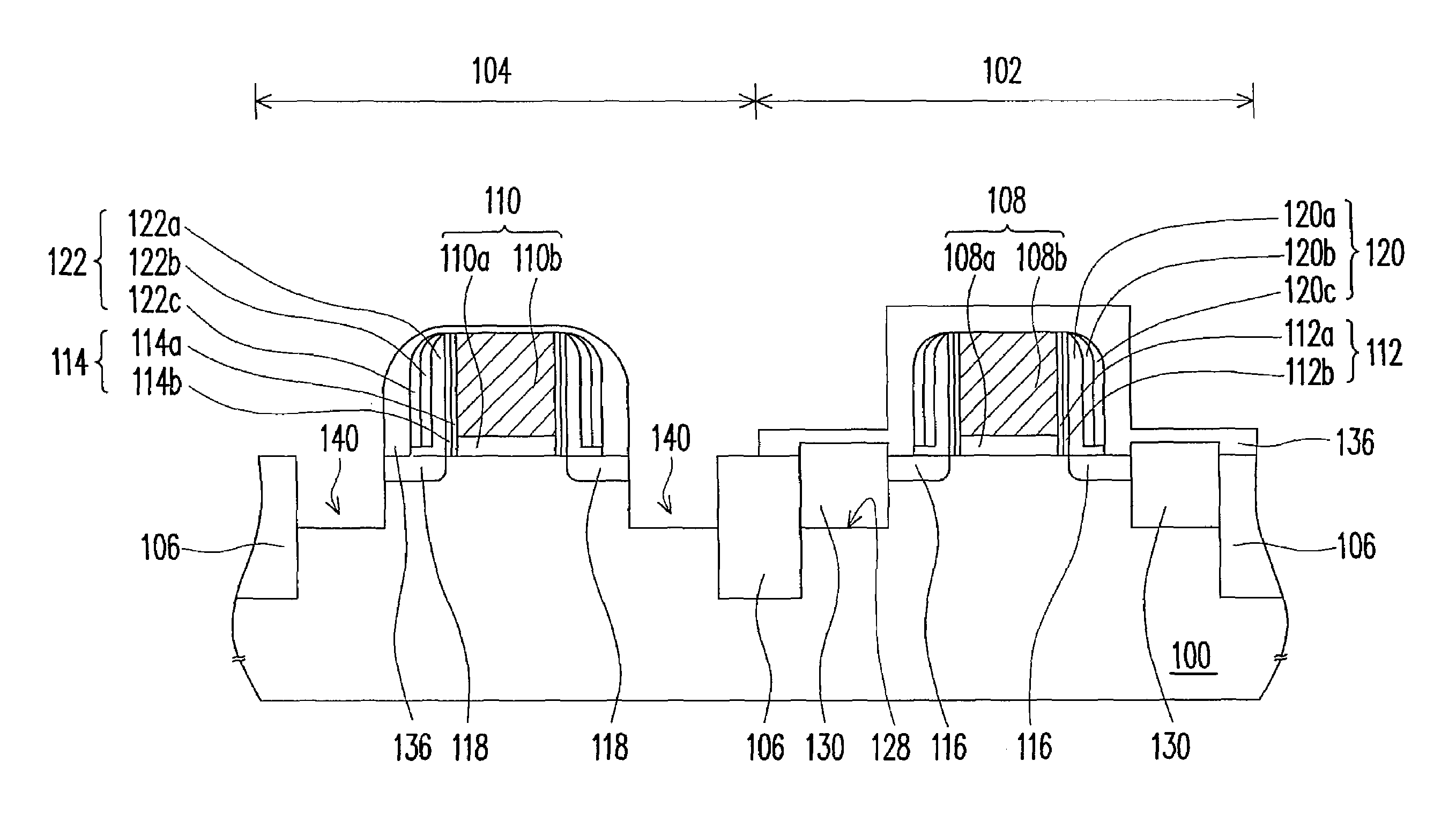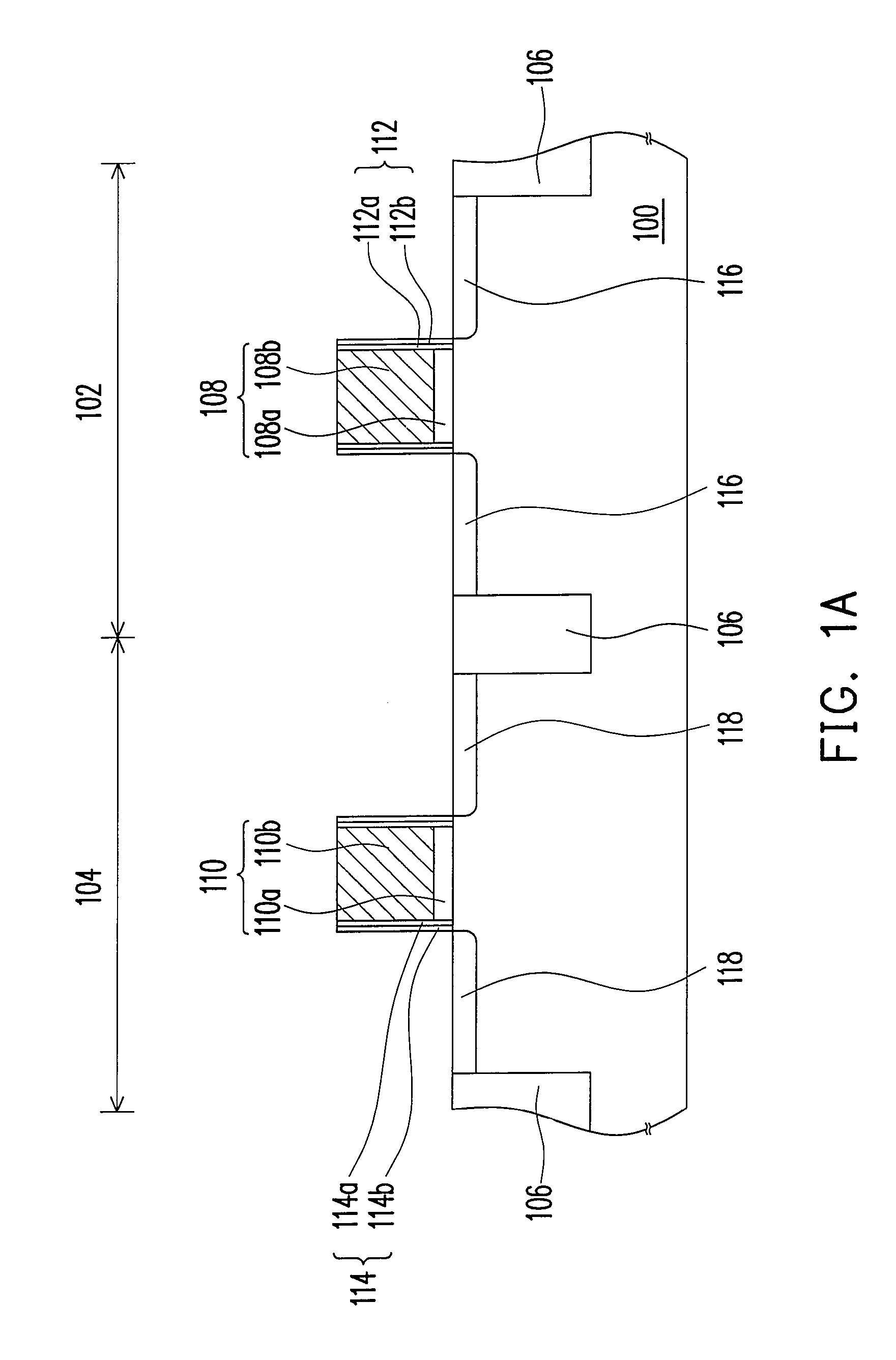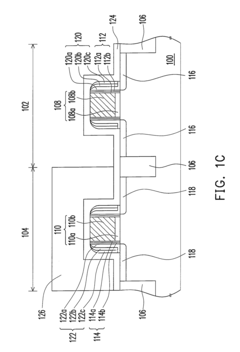CMOS Battery Dynamics in Wearable Technology
JUL 22, 20259 MIN READ
Generate Your Research Report Instantly with AI Agent
Patsnap Eureka helps you evaluate technical feasibility & market potential.
CMOS Battery Evolution
The evolution of CMOS battery technology in wearable devices has been marked by significant advancements in energy density, form factor, and integration capabilities. Initially, wearable devices relied on traditional button cell batteries, which were bulky and limited in capacity. As the demand for more compact and feature-rich wearables grew, the industry saw a shift towards lithium-ion polymer batteries, which offered improved energy density and flexibility in design.
The miniaturization of CMOS technology played a crucial role in this evolution. As CMOS processes became more efficient, the power consumption of wearable devices decreased, allowing for smaller battery sizes without compromising functionality. This synergy between CMOS advancements and battery technology innovations led to the development of ultra-thin, flexible batteries that could be seamlessly integrated into wearable form factors.
A key milestone in CMOS battery evolution was the introduction of power management integrated circuits (PMICs) specifically designed for wearables. These PMICs optimized power distribution and charging processes, significantly extending battery life and enabling more efficient use of available energy. The integration of energy harvesting technologies, such as solar cells and kinetic energy converters, further enhanced the longevity of wearable devices.
Recent years have seen the emergence of solid-state batteries as a promising technology for wearables. These batteries offer higher energy density, improved safety, and the potential for faster charging compared to traditional lithium-ion batteries. The development of thin-film solid-state batteries has been particularly noteworthy, as they can be fabricated directly on silicon wafers, allowing for unprecedented levels of integration with CMOS circuits.
Another significant trend in CMOS battery evolution for wearables has been the focus on biocompatibility and sustainability. As wearable devices increasingly come into direct contact with the skin, there has been a push towards developing batteries that are not only safe but also environmentally friendly. This has led to research into biodegradable batteries and the use of non-toxic materials in battery construction.
The integration of artificial intelligence and machine learning algorithms into wearable devices has also influenced battery technology. These advanced algorithms enable more efficient power management by predicting usage patterns and optimizing device performance accordingly. This has resulted in smarter battery systems that can adapt to user behavior and environmental conditions, further extending the operational life of wearable devices.
Looking ahead, the evolution of CMOS batteries in wearable technology is likely to continue focusing on increasing energy density, improving charging speeds, and enhancing integration capabilities. Emerging technologies such as graphene-based supercapacitors and advanced nanomaterials hold promise for revolutionizing energy storage in wearables, potentially leading to devices that can be charged in seconds and last for weeks.
The miniaturization of CMOS technology played a crucial role in this evolution. As CMOS processes became more efficient, the power consumption of wearable devices decreased, allowing for smaller battery sizes without compromising functionality. This synergy between CMOS advancements and battery technology innovations led to the development of ultra-thin, flexible batteries that could be seamlessly integrated into wearable form factors.
A key milestone in CMOS battery evolution was the introduction of power management integrated circuits (PMICs) specifically designed for wearables. These PMICs optimized power distribution and charging processes, significantly extending battery life and enabling more efficient use of available energy. The integration of energy harvesting technologies, such as solar cells and kinetic energy converters, further enhanced the longevity of wearable devices.
Recent years have seen the emergence of solid-state batteries as a promising technology for wearables. These batteries offer higher energy density, improved safety, and the potential for faster charging compared to traditional lithium-ion batteries. The development of thin-film solid-state batteries has been particularly noteworthy, as they can be fabricated directly on silicon wafers, allowing for unprecedented levels of integration with CMOS circuits.
Another significant trend in CMOS battery evolution for wearables has been the focus on biocompatibility and sustainability. As wearable devices increasingly come into direct contact with the skin, there has been a push towards developing batteries that are not only safe but also environmentally friendly. This has led to research into biodegradable batteries and the use of non-toxic materials in battery construction.
The integration of artificial intelligence and machine learning algorithms into wearable devices has also influenced battery technology. These advanced algorithms enable more efficient power management by predicting usage patterns and optimizing device performance accordingly. This has resulted in smarter battery systems that can adapt to user behavior and environmental conditions, further extending the operational life of wearable devices.
Looking ahead, the evolution of CMOS batteries in wearable technology is likely to continue focusing on increasing energy density, improving charging speeds, and enhancing integration capabilities. Emerging technologies such as graphene-based supercapacitors and advanced nanomaterials hold promise for revolutionizing energy storage in wearables, potentially leading to devices that can be charged in seconds and last for weeks.
Wearable Market Demand
The wearable technology market has experienced significant growth in recent years, driven by increasing consumer demand for health and fitness tracking devices, smartwatches, and other connected wearables. This trend has created a substantial market opportunity for CMOS battery technology in wearable devices.
The global wearable technology market size was valued at $61.30 billion in 2022 and is projected to reach $184.40 billion by 2030, growing at a CAGR of 14.8% from 2023 to 2030. This rapid expansion is fueled by factors such as rising health consciousness, technological advancements, and the increasing adoption of IoT devices.
Within the wearable market, smartwatches and fitness trackers dominate the landscape, accounting for a significant portion of the market share. These devices rely heavily on efficient power management systems, making CMOS battery technology a critical component in their design and functionality.
Consumer demand for wearables is primarily driven by health and fitness applications, with features such as heart rate monitoring, sleep tracking, and activity tracking being highly sought after. This focus on health-related functionalities has led to an increased need for longer battery life and more efficient power management solutions in wearable devices.
The COVID-19 pandemic has further accelerated the adoption of wearable technology, as consumers have become more health-conscious and interested in monitoring their vital signs. This shift has created additional demand for wearables with advanced sensors and longer battery life, putting pressure on manufacturers to improve CMOS battery technology.
In the enterprise sector, there is a growing demand for wearables in industries such as healthcare, manufacturing, and logistics. These applications often require devices with extended battery life and reliable performance in challenging environments, further emphasizing the importance of advanced CMOS battery solutions.
Geographically, North America and Europe lead the wearable technology market, with Asia-Pacific expected to show the fastest growth in the coming years. This regional distribution of market demand influences the development and adoption of CMOS battery technology across different markets.
As consumers increasingly expect longer battery life and more advanced features in their wearable devices, there is a clear market need for innovations in CMOS battery technology. This demand is driving research and development efforts to create more efficient, compact, and long-lasting power solutions for wearable devices.
The global wearable technology market size was valued at $61.30 billion in 2022 and is projected to reach $184.40 billion by 2030, growing at a CAGR of 14.8% from 2023 to 2030. This rapid expansion is fueled by factors such as rising health consciousness, technological advancements, and the increasing adoption of IoT devices.
Within the wearable market, smartwatches and fitness trackers dominate the landscape, accounting for a significant portion of the market share. These devices rely heavily on efficient power management systems, making CMOS battery technology a critical component in their design and functionality.
Consumer demand for wearables is primarily driven by health and fitness applications, with features such as heart rate monitoring, sleep tracking, and activity tracking being highly sought after. This focus on health-related functionalities has led to an increased need for longer battery life and more efficient power management solutions in wearable devices.
The COVID-19 pandemic has further accelerated the adoption of wearable technology, as consumers have become more health-conscious and interested in monitoring their vital signs. This shift has created additional demand for wearables with advanced sensors and longer battery life, putting pressure on manufacturers to improve CMOS battery technology.
In the enterprise sector, there is a growing demand for wearables in industries such as healthcare, manufacturing, and logistics. These applications often require devices with extended battery life and reliable performance in challenging environments, further emphasizing the importance of advanced CMOS battery solutions.
Geographically, North America and Europe lead the wearable technology market, with Asia-Pacific expected to show the fastest growth in the coming years. This regional distribution of market demand influences the development and adoption of CMOS battery technology across different markets.
As consumers increasingly expect longer battery life and more advanced features in their wearable devices, there is a clear market need for innovations in CMOS battery technology. This demand is driving research and development efforts to create more efficient, compact, and long-lasting power solutions for wearable devices.
CMOS Battery Challenges
The integration of CMOS (Complementary Metal-Oxide-Semiconductor) batteries into wearable technology presents a unique set of challenges that researchers and manufacturers must address to ensure optimal performance and user experience. One of the primary obstacles is the limited energy density of CMOS batteries, which constrains the operational lifespan of wearable devices between charges. This limitation is particularly pronounced in compact wearables where space is at a premium, necessitating innovative approaches to power management and battery design.
Another significant challenge lies in the thermal management of CMOS batteries in wearable applications. The close proximity of these power sources to the user's skin raises concerns about heat dissipation and user comfort. Overheating not only affects the battery's performance and longevity but also poses potential safety risks, making efficient thermal design a critical consideration in wearable technology development.
The charging efficiency of CMOS batteries in wearable devices presents yet another hurdle. The need for frequent charging can be inconvenient for users, while rapid charging solutions may compromise battery life or increase the risk of overheating. Balancing these factors to provide a seamless user experience without sacrificing device longevity remains a complex challenge for engineers.
Durability and flexibility are also key concerns in the context of wearable technology. CMOS batteries must withstand the physical stresses associated with daily wear, including bending, stretching, and potential impact. Developing battery technologies that maintain performance under these conditions while remaining lightweight and comfortable for the user is an ongoing area of research and development.
Environmental factors pose additional challenges for CMOS batteries in wearables. Exposure to varying temperatures, humidity, and potential water ingress can affect battery performance and safety. Designing robust enclosures and protective measures without significantly increasing device bulk or weight requires careful engineering and material selection.
The integration of CMOS batteries with other components in wearable devices presents its own set of challenges. Minimizing electromagnetic interference between the battery and sensitive sensors or communication modules is crucial for maintaining device accuracy and reliability. Additionally, optimizing the power delivery to various components with different energy requirements demands sophisticated power management systems.
Lastly, the environmental impact and recyclability of CMOS batteries in wearable technology are becoming increasingly important considerations. As the market for wearable devices expands, addressing the end-of-life disposal and recycling of these batteries becomes critical for sustainability. Developing eco-friendly battery technologies and implementing effective recycling processes are essential steps in mitigating the environmental footprint of wearable devices.
Another significant challenge lies in the thermal management of CMOS batteries in wearable applications. The close proximity of these power sources to the user's skin raises concerns about heat dissipation and user comfort. Overheating not only affects the battery's performance and longevity but also poses potential safety risks, making efficient thermal design a critical consideration in wearable technology development.
The charging efficiency of CMOS batteries in wearable devices presents yet another hurdle. The need for frequent charging can be inconvenient for users, while rapid charging solutions may compromise battery life or increase the risk of overheating. Balancing these factors to provide a seamless user experience without sacrificing device longevity remains a complex challenge for engineers.
Durability and flexibility are also key concerns in the context of wearable technology. CMOS batteries must withstand the physical stresses associated with daily wear, including bending, stretching, and potential impact. Developing battery technologies that maintain performance under these conditions while remaining lightweight and comfortable for the user is an ongoing area of research and development.
Environmental factors pose additional challenges for CMOS batteries in wearables. Exposure to varying temperatures, humidity, and potential water ingress can affect battery performance and safety. Designing robust enclosures and protective measures without significantly increasing device bulk or weight requires careful engineering and material selection.
The integration of CMOS batteries with other components in wearable devices presents its own set of challenges. Minimizing electromagnetic interference between the battery and sensitive sensors or communication modules is crucial for maintaining device accuracy and reliability. Additionally, optimizing the power delivery to various components with different energy requirements demands sophisticated power management systems.
Lastly, the environmental impact and recyclability of CMOS batteries in wearable technology are becoming increasingly important considerations. As the market for wearable devices expands, addressing the end-of-life disposal and recycling of these batteries becomes critical for sustainability. Developing eco-friendly battery technologies and implementing effective recycling processes are essential steps in mitigating the environmental footprint of wearable devices.
Current CMOS Solutions
01 CMOS battery power management
CMOS batteries are crucial for maintaining system settings and real-time clock functions in electronic devices. Power management techniques are implemented to optimize battery life and performance, including intelligent charging algorithms, low-power modes, and voltage regulation systems.- CMOS battery power management: CMOS batteries play a crucial role in maintaining system settings and real-time clock functions in electronic devices. Power management techniques are implemented to optimize battery life and performance, including intelligent charging algorithms, low-power modes, and voltage regulation mechanisms.
- CMOS battery monitoring and replacement: Systems are designed to monitor CMOS battery health, voltage levels, and predict potential failures. Automated notifications and easy replacement mechanisms are implemented to ensure continuous operation of critical system functions that rely on CMOS battery power.
- CMOS battery integration with system-on-chip designs: Modern system-on-chip (SoC) designs incorporate CMOS battery management directly into the chip architecture. This integration allows for more efficient power distribution, reduced footprint, and improved overall system reliability in portable and embedded devices.
- CMOS battery backup and data retention strategies: Advanced techniques are employed to ensure data retention and system state preservation during main power loss or battery replacement. These strategies include capacitor-based temporary backup, non-volatile memory integration, and rapid switching mechanisms between power sources.
- CMOS battery technology advancements: Ongoing research focuses on improving CMOS battery technology, including the development of higher capacity, longer-lasting batteries, and exploration of alternative power sources such as energy harvesting techniques to supplement or replace traditional CMOS batteries in certain applications.
02 CMOS battery monitoring and replacement
Systems and methods for monitoring CMOS battery health, predicting battery life, and alerting users when replacement is necessary. This includes voltage level detection, charge cycle tracking, and automated notification systems to ensure uninterrupted device operation.Expand Specific Solutions03 CMOS battery integration in semiconductor devices
Advancements in integrating CMOS batteries directly into semiconductor devices, improving efficiency and reducing form factor. This involves novel packaging techniques, on-chip power management circuits, and the use of advanced materials for enhanced battery performance.Expand Specific Solutions04 CMOS battery backup systems
Development of backup power systems for CMOS batteries to prevent data loss during main battery failure or replacement. These systems include secondary power sources, capacitor-based solutions, and intelligent power switching mechanisms to maintain critical system functions.Expand Specific Solutions05 CMOS battery technology for IoT and wearable devices
Innovations in CMOS battery technology tailored for Internet of Things (IoT) and wearable devices, focusing on miniaturization, extended life, and energy harvesting capabilities. This includes the development of flexible batteries, ultra-low-power CMOS circuits, and integration with energy-efficient sensors.Expand Specific Solutions
Wearable CMOS Leaders
The CMOS battery dynamics in wearable technology market is in a growth phase, driven by increasing demand for smart wearables. The market size is expanding rapidly, with major players like Samsung, Huawei, and Vivo investing heavily in R&D. Technologically, the field is advancing quickly but still maturing. Companies like LiBEST and AMOGREENTECH are developing innovative flexible battery solutions, while established players like Maxell and Suunto are leveraging their expertise in energy storage. The competition is fierce, with both tech giants and specialized firms vying for market share in this promising sector.
Samsung Electronics Co., Ltd.
Technical Solution: Samsung has developed advanced CMOS battery technology for wearables, focusing on miniaturization and energy efficiency. Their approach involves using thin-film lithium batteries with CMOS-compatible fabrication processes[1]. This integration allows for direct on-chip energy storage, significantly reducing the overall size of wearable devices. Samsung's technology utilizes a solid-state electrolyte, which enhances safety and allows for flexible form factors[2]. The company has also implemented advanced power management circuits that optimize battery performance and extend device runtime[3].
Strengths: Miniaturization capabilities, integration with existing CMOS processes, improved safety. Weaknesses: Potentially higher production costs, limited energy density compared to traditional lithium-ion batteries.
Huawei Technologies Co., Ltd.
Technical Solution: Huawei has invested in CMOS battery technology for wearables, focusing on high-density energy storage and rapid charging capabilities. Their approach involves using silicon-based anodes in lithium-ion batteries, which can significantly increase energy density[4]. Huawei has also developed proprietary fast-charging protocols that can replenish up to 70% of battery capacity in just 30 minutes[5]. Additionally, they have implemented AI-powered battery management systems that adapt to user behavior, optimizing power consumption and extending battery life[6].
Strengths: High energy density, fast charging capabilities, intelligent power management. Weaknesses: Potential thermal management issues, higher production costs.
Key CMOS Innovations
System and method for integrated circuit usage tracking circuit with fast tracking time for hardware security and re-configurability
PatentActiveUS20160329897A1
Innovation
- A silicon marker technique using conventional CMOS devices with an accelerated aging circuit and stochastic processing methodology to create a reliable usage marker within seconds, leveraging NBTI effects and latch-based comparator circuits to enhance detection accuracy and tolerance to process variations.
Complementary metal-oxide-semiconductor device and fabricating method thereof
PatentActiveUS7402496B2
Innovation
- A method involving the use of a carbon-containing oxynitride passivation layer with a low etching rate, formed through low-pressure chemical-vapor deposition, is employed to prevent the improper removal of the passivation layer during device manufacturing, and a thermal process is applied to densify the passivation layer, reducing the etching rate and avoiding the formation of poly bumps.
Power Management ICs
Power Management ICs play a crucial role in optimizing CMOS battery dynamics for wearable technology. These integrated circuits are designed to efficiently manage power consumption, extend battery life, and enhance overall performance in compact, energy-constrained devices. In the context of wearable technology, power management ICs must address unique challenges posed by the limited form factor and diverse operational modes of these devices.
One of the primary functions of power management ICs in wearable devices is voltage regulation. These ICs employ advanced techniques such as dynamic voltage scaling and adaptive voltage positioning to ensure stable power delivery across various operational states. By dynamically adjusting voltage levels based on the device's current workload, power management ICs can significantly reduce energy waste and prolong battery life.
Another key feature of modern power management ICs is their ability to implement sophisticated power gating strategies. This technique allows for selective powering down of unused circuit blocks within the wearable device, effectively minimizing static power consumption. Power gating is particularly beneficial in wearables that alternate between active and standby modes frequently, such as fitness trackers and smartwatches.
Power management ICs also incorporate advanced battery charging and monitoring capabilities. These features are essential for maintaining the health and longevity of CMOS batteries in wearable devices. Intelligent charging algorithms implemented within the ICs can optimize charging cycles, prevent overcharging, and adapt to various battery chemistries commonly used in wearables.
Furthermore, power management ICs in wearable technology often integrate energy harvesting management functions. This capability allows wearables to supplement their battery power with energy scavenged from the environment, such as body heat, motion, or ambient light. The IC manages the conversion and storage of this harvested energy, further extending the device's operational time between charges.
To address the stringent size constraints of wearable devices, power management IC manufacturers are continually pushing the boundaries of integration and miniaturization. Modern ICs often combine multiple power management functions into a single chip, including voltage regulators, battery chargers, and power switches. This high level of integration not only saves valuable space within the device but also reduces overall system complexity and cost.
As wearable technology continues to evolve, power management ICs are adapting to support new features and functionalities. For instance, many recent ICs incorporate specialized power modes to support always-on sensing and low-power wireless communication protocols. These advancements enable wearables to maintain constant connectivity and data collection while minimizing power consumption.
One of the primary functions of power management ICs in wearable devices is voltage regulation. These ICs employ advanced techniques such as dynamic voltage scaling and adaptive voltage positioning to ensure stable power delivery across various operational states. By dynamically adjusting voltage levels based on the device's current workload, power management ICs can significantly reduce energy waste and prolong battery life.
Another key feature of modern power management ICs is their ability to implement sophisticated power gating strategies. This technique allows for selective powering down of unused circuit blocks within the wearable device, effectively minimizing static power consumption. Power gating is particularly beneficial in wearables that alternate between active and standby modes frequently, such as fitness trackers and smartwatches.
Power management ICs also incorporate advanced battery charging and monitoring capabilities. These features are essential for maintaining the health and longevity of CMOS batteries in wearable devices. Intelligent charging algorithms implemented within the ICs can optimize charging cycles, prevent overcharging, and adapt to various battery chemistries commonly used in wearables.
Furthermore, power management ICs in wearable technology often integrate energy harvesting management functions. This capability allows wearables to supplement their battery power with energy scavenged from the environment, such as body heat, motion, or ambient light. The IC manages the conversion and storage of this harvested energy, further extending the device's operational time between charges.
To address the stringent size constraints of wearable devices, power management IC manufacturers are continually pushing the boundaries of integration and miniaturization. Modern ICs often combine multiple power management functions into a single chip, including voltage regulators, battery chargers, and power switches. This high level of integration not only saves valuable space within the device but also reduces overall system complexity and cost.
As wearable technology continues to evolve, power management ICs are adapting to support new features and functionalities. For instance, many recent ICs incorporate specialized power modes to support always-on sensing and low-power wireless communication protocols. These advancements enable wearables to maintain constant connectivity and data collection while minimizing power consumption.
Energy Harvesting Tech
Energy harvesting technologies are becoming increasingly crucial in the realm of wearable devices, particularly in addressing the challenges associated with CMOS battery dynamics. These innovative techniques aim to capture and convert ambient energy from the environment into usable electrical power, potentially extending the battery life of wearable devices or even eliminating the need for traditional batteries altogether.
One of the most promising energy harvesting methods for wearable technology is thermoelectric generation. This technique leverages the temperature difference between the human body and the surrounding environment to generate electricity. By incorporating thermoelectric materials into the fabric or structure of wearable devices, it becomes possible to continuously harvest small amounts of energy from body heat.
Another emerging approach is piezoelectric energy harvesting, which converts mechanical stress or vibrations into electrical energy. This technology can be integrated into shoes, clothing, or accessories to capture energy from the wearer's movements, such as walking or running. The generated power, while small, can contribute to extending the operational time of low-power wearable devices.
Photovoltaic cells, miniaturized for wearable applications, offer another avenue for energy harvesting. These cells can be incorporated into the surface of smartwatches, fitness trackers, or even clothing to capture light energy and convert it into electricity. Recent advancements in flexible and transparent solar cells have made this technology increasingly viable for wearable applications.
Electromagnetic energy harvesting is also gaining traction in the wearable technology sector. This method involves capturing energy from ambient electromagnetic fields, such as those generated by Wi-Fi routers or cellular networks. While the power output is typically low, it can be sufficient to support low-power sensors and communication modules in wearable devices.
Radio frequency (RF) energy harvesting is a related technique that shows promise for wearable technology. This approach involves capturing energy from radio waves in the environment and converting it into usable power. As the number of wireless devices and networks continues to grow, RF energy harvesting could become an increasingly viable option for powering wearable devices.
The integration of these energy harvesting technologies with efficient power management systems and low-power CMOS circuits is crucial for maximizing their effectiveness in wearable devices. By combining multiple harvesting techniques and optimizing power consumption, it may be possible to significantly reduce the reliance on traditional batteries, leading to longer-lasting and more environmentally friendly wearable technology solutions.
One of the most promising energy harvesting methods for wearable technology is thermoelectric generation. This technique leverages the temperature difference between the human body and the surrounding environment to generate electricity. By incorporating thermoelectric materials into the fabric or structure of wearable devices, it becomes possible to continuously harvest small amounts of energy from body heat.
Another emerging approach is piezoelectric energy harvesting, which converts mechanical stress or vibrations into electrical energy. This technology can be integrated into shoes, clothing, or accessories to capture energy from the wearer's movements, such as walking or running. The generated power, while small, can contribute to extending the operational time of low-power wearable devices.
Photovoltaic cells, miniaturized for wearable applications, offer another avenue for energy harvesting. These cells can be incorporated into the surface of smartwatches, fitness trackers, or even clothing to capture light energy and convert it into electricity. Recent advancements in flexible and transparent solar cells have made this technology increasingly viable for wearable applications.
Electromagnetic energy harvesting is also gaining traction in the wearable technology sector. This method involves capturing energy from ambient electromagnetic fields, such as those generated by Wi-Fi routers or cellular networks. While the power output is typically low, it can be sufficient to support low-power sensors and communication modules in wearable devices.
Radio frequency (RF) energy harvesting is a related technique that shows promise for wearable technology. This approach involves capturing energy from radio waves in the environment and converting it into usable power. As the number of wireless devices and networks continues to grow, RF energy harvesting could become an increasingly viable option for powering wearable devices.
The integration of these energy harvesting technologies with efficient power management systems and low-power CMOS circuits is crucial for maximizing their effectiveness in wearable devices. By combining multiple harvesting techniques and optimizing power consumption, it may be possible to significantly reduce the reliance on traditional batteries, leading to longer-lasting and more environmentally friendly wearable technology solutions.
Unlock deeper insights with Patsnap Eureka Quick Research — get a full tech report to explore trends and direct your research. Try now!
Generate Your Research Report Instantly with AI Agent
Supercharge your innovation with Patsnap Eureka AI Agent Platform!
